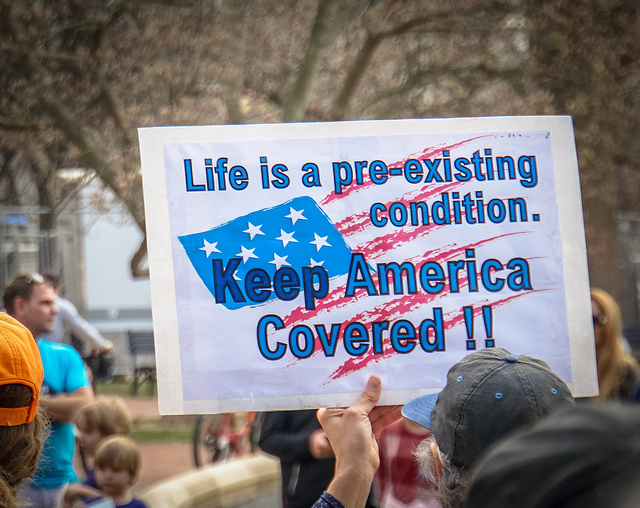
This week, two House committees will work on legislation to replace the Affordable Care Act (“Obamacare”). While “repeal” has been a Republican goal from the day President Obama signed it into law, and “repeal and replace” was a central part of President Trump’s campaign, we are just getting the critical details of what the new approach will look like and can begin to judge how it will affect the lives of the millions who will have to depend on it for health care along with the functions of the thousands of nonprofits that will have to work with it. These include not just hospitals and health centers, but substance abuse facilities, home health care and nursing home facilities, and hospice operations, among many other types of services. NPQ would love to hear from all nonprofits that will be directly affected.
Early last week, President Trump spoke about the new health care system, but only in generalities: “We have come up with a solution that’s really, really…I think, very good.” On February 28th, in his address to a joint session of Congress, he described the new system as one that would “expand choice, increase access, lower costs, and at the same time, provide better healthcare.” He challenged Congress to enact legislation that would provide benefits that many healthcare experts felt could not be affordable combined in one package:
- “Ensure that Americans with pre-existing conditions have access to coverage…
- …have a stable transition for Americans currently enrolled in the healthcare exchanges
- …help Americans purchase their own coverage, through the use of tax credits and expanded Health Savings Accounts
- …be the plan they want, not the plan forced on them by the government
- …give…state governors the resources and flexibility they need with Medicaid to make sure no one is left out
- …protect patients and doctors from unnecessary costs that drive up the price of insurance
- …bring down the artificially high price of drugs and bring them down immediately
- …give Americans the freedom to purchase health insurance across State lines…”
We now have access to sections of the draft American Health Care Act, (more sections are available here) released Monday evening by House leaders working in collaboration with the Trump administration. The draft bill language is designed to be included in the annual budget reconciliation and not introduced as its own legislation. Using budget reconciliation as a vehicle, as was done with key budget and tax provisions of the ACA itself, the AHCA can be approved by the Senate by a simple majority vote, bypassing the 60-vote requirement to avoid a filibuster under Senate rules.
The AHCA fulfills a key Republican promise by eliminating the ACA-imposed obligation for people to be insured (“individual mandate”) and the tax penalty for those who do not comply. Most of the ACA-related taxes will be repealed, including the tanning bed tax, the tax on so-called “Cadillac” health insurance plans, and the 3.8 percent net investment tax levied on individuals with incomes over $250,000. The proposed bill will cover preexisting conditions without penalty and it will try to discourage people from only buying insurance when they have a need for it by allowing insurers to add a penalty for resuming dropped coverage. It will continue to allow children to remain on their parents’ policies through age 26. The proposal provides federal funding to support state-based risk pools to cover individuals who find insurance coverage difficult to find or too expensive to buy directly from insurance companies. The draft replaces the direct subsidies of the ACA with individual tax credits dependent on a combination of an individual’s age and income, reflecting NPQ reporting last week on several GOP healthcare reform options, including a “discussion draft” circulated in House Republican circles in February. But the size of health insurance tax credits remains unclear, making any judgment on how coverage will be affected impossible.
It is also unclear what will happen to Medicaid funding for the 31 states that opted to expand Medicaid eligibility criteria under the ACA. This has become a particularly contentious issue. Conservatives have wished to cut back the cost of Medicaid, citing its federal share cost tripling since the 1990s and what they see as an unsustainable future budget trajectory. Liberals have strongly protested the potential loss of coverage to approximately 11 million people who became insured as a result of the ACA’s Medicaid expansion provisions. State governments are nervous about losing the ACA-based federal guarantee that they would never have to pay more than 10 percent of the costs associated with Medicaid expansion (as opposed to the state share of 35-40 percent of Medicaid costs for other covered residents). What we do know is that the newly-released draft bill maintains the earlier discussion draft legislation’s provisions to cease new Medicaid expansion enrollments in 2020, with the accompanying expectation that the number of individuals covered under Medicaid expansion will be reduced over time as their incomes rise above the qualification thresholds or they receive employer-based insurance.
Responding to the concerns of many hospitals and healthcare systems, the bill reverses the ACA’s cuts in so-called federal “disproportionate share hospital” (DSH) supplemental Medicaid payments to hospitals that treat an unusually large share of uninsured patients and patients covered under Medicaid. It also increases funding support for community health centers.
Every large bill has its unusual provisions, and the AHCA adds an intriguing provision not included in previous drafts. Seven pages of the bill address a state’s ability to disenroll lottery winners receiving Medicaid benefits and recover Medicaid costs paid on behalf of lottery winners, complete with a jackpot-based sliding scale and consideration of lump sum versus annuity payments.
The AHCA retains the legislative language contained in the discussion draft that would effectively defund Planned Parenthood. NPQ’s reporting on the discussion draft included a sidebar illustrating how the bill can defund a nonprofit without ever naming it.
Sign up for our free newsletters
Subscribe to NPQ's newsletters to have our top stories delivered directly to your inbox.
By signing up, you agree to our privacy policy and terms of use, and to receive messages from NPQ and our partners.
Responding to the February 10th House “discussion draft,” four Republican Senators have indicated they will not support a bill that does not protect the Medicaid expansion provisions of the ACA. Sens. Rob Portman (R-OH), Shelley Moore Capito (R-WV), Cory Gardner (R-CO), and Lisa Murkowski (R-AK) told Senate Majority Leader Mitch McConnell that “We believe Medicaid needs to be reformed, but reform should not come at the cost of disruption in access to health care for our country’s most vulnerable and sickest individuals. Any changes made to how Medicaid is financed through the state and federal governments should be coupled with significant new flexibility so they can efficiently and effectively manage their Medicaid programs to best meet their own needs.” The senators affirm their commitment to “repeal and replace,” but are seeking “stability for Medicaid expansion populations” and a “gradual transition” rather than a sudden shift in health insurance coverage options.
Release of the AHCA draft ended an almost comic weekend in which only some Republican members of the House were given access to the conference room where the draft bill could be read. Democratic representatives and all Senators had been barred and were sent scurrying trying to find a “leak.” While House Speaker Paul Ryan’s had claimed on national TV that “We’re not hatching some bill in a backroom and plopping it on the American people’s front door,” the reality seemed so different. Sen. Rand Paul (R-KY), who has introduced his own “repeal and replace” legislation, tweeted, “I have been told that the House Obamacare bill is under lock & key, in a secure location, & not available for me or the public to view.”
For the American people, particularly on an issue of such importance, the lack of process should be of concern. With no specifics available, it was not possible for anyone to consider what the impact of the changes to providing healthcare insurance and healthcare access might be. Now, we can begin to answer key questions about the new approach. Will any number of Americans lose coverage that they gained under the ACA? If so, which groups will be most negatively affected? What will the new programs cost? How much of the costs will be covered by anticipated Medicaid savings and the proposed version of the “Cadillac” tax, which would limit the tax deductibility of health insurance premiums exceeding a threshold tied to inflation? Now the Congressional Budget Office (CBO), the body responsible for doing the math (or, using Congressional jargon, “scoring” the legislation), can begin to let everyone, especially those who will have to vote, know what the score is. It still appears, however, that when members of the House Energy and Commerce and House Ways and Means committees “mark up” the legislation later this week, they will not have taken the time needed to allow the CBO give them that information.
This appears to be a very different process than that leading up to votes on a very contentious effort to craft the ACA. Topher Spiro, deputy staff director for the Senate HELP Committee while the ACA was being crafted, described the process for the Washington Post:
In the House, Democrats held a series of public hearings before introducing a public discussion draft in June 2009. The House then held more public hearings before introducing new legislative text in July. All three relevant committees held “markups”—committee work sessions to amend the legislation—and the full House vote on the amended legislation did not take place until November. In the Senate, the HELP Committee held 14 bipartisan roundtables and 13 public hearings in 2008 and 2009. During the committee’s markup in June 2009, Democrats accepted more than 160 Republican amendments to the bill.
Ultimately, the ACA was enacted in 2010 by one vote, with only Democrats voting in support. The politics of “repeal and replace” currently appear to mirror that approach, with the current proposed legislation being an all-GOP effort, though hardly a united one. NPQ recently reported on the five GOP factions that must be reconciled before a Congressional majority has a chance of passing health care reform legislation. Just as ACA enactment relied on provisions like the “Louisiana Purchase” and the “Cornhusker kickback” to cement moderate Democratic support, watch for the AHCA to include provisions designed to assure support from key individual Republican legislators.
President Trump might be the last political leader in the country to realize the complexity of healthcare policy. “It’s an unbelievably complex subject,” he said last week. “Nobody knew that healthcare could be so complicated.” We knew it and have known it for decades. The details matter. Understanding how the law will affect the health and lives of millions of Americans, never mind the thousands of nonprofits providing services to them, is a matter of great import. We can only hope that getting it right for the people whose lives are depending on the final outcome is more important than just making the politics work.












